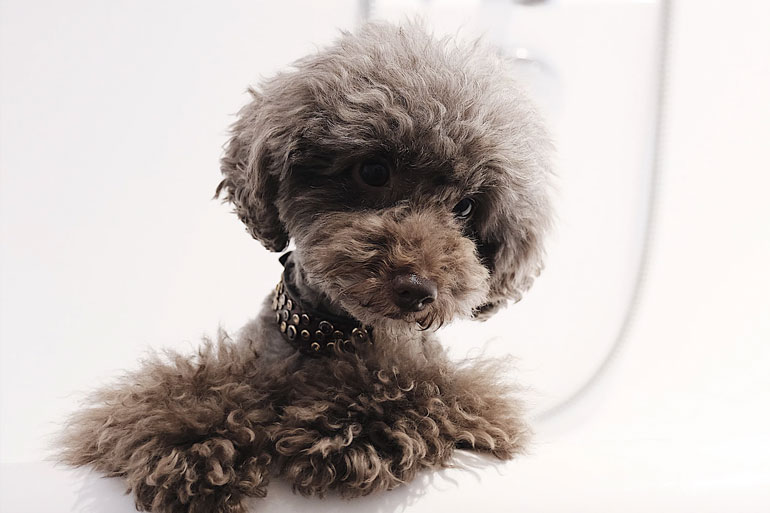Matted Pets: How to Deal With Minor and Severe Tangles
Matted pets can look really disheveled, but the poor state of their coat is more than just a simple issue with their appearance. Matting can cause real discomfort, and in some cases, can even pose a health risk.
Therefore, it’s very important to remove mats when they appear.
In this quick post, we will take you through the process of dematting, looking at both minor and severe matting.
Dealing with Minor Tangles and Knots
Minor tangles and knots can be removed at home and should be taken care of as soon as possible before they worsen and become unmanageable.
In such cases, you should first attempt to brush out the tangles. Cutting them away can be dangerous and should be left to an expert.
First things first, don’t bathe your dog or cat until the tangles are dealt with. The water will only serve to tighten the knots further. Instead, use an appropriate detangler spray.
To brush out mats in the safest and least painful way possible, hold the fur closest to the skin underneath the tangle. From there, start at the end of the tangle and work your way up.
This can help prevent any pulling on the skin.
Dealing with Severely Matted Pets
However, in some cases, brushing and detangler simply aren’t enough. In cases of severe matting, the only choice that may remain is to cut away or shave the matted area entirely.
In extreme cases, the entire coat may have to be shaved.
It’s recommended to not deal with such cases on your own. Instead, give us a call! Our groomers are professionally trained and carry out our dematting service in the safest way possible.
Why Do We Shave Severely Matted Pets?
Sometimes the best thing we can do to help a badly matted pet is to shave their coat.
Some think this to be an extreme course of action; it’s only a few knots, right? Why not just trim them off?
Unfortunately, in some cases, this is much too dangerous to do. Large knots that are close to the skin are hard to snip off safely and pulling on them causes a great deal of pain.
Shaving the affected area of the coat is the safest and least painful way of dealing with such cases. It also comes with the benefit that it will reveal any skin issues, which can be likely in areas that were previously matted.
Preventing Mats from Forming
The best way to deal with mats is to prevent them from forming in the first place.
You can do this by taking care of your pet’s coat proactively, always making sure to give them a good brush over before they end up in a matted condition.
Keep in mind that every breed of cat or dog needs varying amounts of grooming to keep them maintained. A Poodle, for example, is going to require a lot more daily work than a short haired Pug.
We at Groomit are here to help you keep on top of grooming. Having them looked at by a professional regularly can be a great way of keeping them looking great and helping them stay healthy.
Dematting: A Necessary and Sometimes Tough Process
Dematting can be hard work for the groomer and uncomfortable for the pet, but it is a necessary process without any real alternatives.
You cannot simply leave a pet matted; it will get worse and worse. In extreme cases, it can even begin to block their poop or cut off circulation to parts of the body.
Therefore, if you have a severely matted pet, consider letting us see them! Our professionally trained groomers will ensure that your pets remain safe and as comfortable as possible during the entire process.
Keep in mind that in cases of severe matting, shaving parts or all of the coat may be necessary. We hope this article gave you everything you needed to know about matted fur and how it is dealt with. Remember to make an appointment with us now if you have any matted pets!
Having a good dematting brush can also help a lot. Check this link for recommendations for dogs, and this link for the best brushes for cats.
FAQ’s
Q: How do I prevent my pet’s fur from getting tangled or matted?
A: Preventing tangles and mats in your pet’s fur involves regular grooming and maintenance. Here are some tips to help prevent tangles:
Regular brushing: Brush your pet’s fur regularly, especially if they have long or dense hair. Brushing helps remove loose hair and prevents it from matting.
Use a detangling spray: Spritz a pet-friendly detangling spray before brushing to make the fur more manageable and reduce the likelihood of tangles.
Pay attention to problem areas: Some areas, such as behind the ears, armpits, and tail, are prone to tangling. Give extra attention to these areas during grooming.
Trim long hair: If your pet has long hair, consider regular trims to maintain a manageable length and reduce the chances of matting.
Professional grooming: Schedule regular visits to a professional groomer who can help keep your pet’s fur in good condition and address any potential matting issues.
Q: How do I determine if my pet’s tangles or mats are minor or severe?
A: Determining the severity of tangles or mats in your pet’s fur can help guide your approach to addressing them. Here are some signs to look for:
Size and thickness: Minor tangles are usually small and can be easily separated with gentle brushing or combing. Severe mats, on the other hand, are larger, denser, and may feel tight against the skin.
Discomfort or pain: Minor tangles may cause slight discomfort but can be untangled without causing significant distress to your pet. Severe mats often cause pain, sensitivity, or inflammation in the affected area.
Hair loss or skin irritation: Severe mats can lead to hair loss, skin irritation, or even sores due to the tightness of the mat against the skin.
If you’re unsure about the severity of the tangles or mats, it’s best to consult with a professional groomer or veterinarian. They can assess the situation and provide appropriate guidance.
Q: Can I remove tangles or mats from my pet’s fur by myself?
A: Minor tangles can often be safely addressed at home with proper techniques and tools. However, attempting to remove severe mats by yourself can be challenging and potentially harmful to your pet. Here’s what you need to know:
Minor tangles: With patience, gentle handling, and the right tools such as a wide-toothed comb or a detangling spray, you can often untangle minor knots yourself.
Severe mats: Severe mats require professional attention. Removing them without the necessary expertise can cause pain, skin irritation, or even injury to your pet. It’s best to consult a professional groomer who has the knowledge and tools to safely handle severe mats.
Seek professional help: If you’re unsure or uncomfortable with dealing with tangles or mats, or if you notice any signs of discomfort or skin issues, it’s recommended to seek professional help from a groomer or veterinarian.
Q: Can I prevent my pet from getting severe mats if they have long or dense fur?
A: While it may be challenging to completely prevent mats in pets with long or dense fur, there are steps you can take to minimize the occurrence of severe mats. Consider the following:
Regular grooming: Schedule regular grooming sessions to keep your pet’s fur clean and well-maintained. Brushing and combing help prevent tangles and mats from forming.
Professional grooming: Professional groomers have the expertise and tools to manage long or dense fur. Regular visits to a groomer can help keep the fur in good condition and reduce the chances of severe matting.
Trimming: Consider regular trims to maintain a manageable fur length. Trimming can help prevent excessive tangling and matting.
Focus on problem areas: Pay extra attention to areas that are prone to matting, such as behind the ears, under the arms, and around the tail. Brush and comb these areas regularly to prevent mats from forming.
Regular checks: Regularly inspect your pet’s fur for any signs of tangles or mats. Catching them early can prevent them from becoming severe.
Q: Can severe mats in my pet’s fur lead to health problems?
A: Severe mats in your pet’s fur can indeed lead to various health problems. Here are some potential issues associated with severe mats:
Skin irritation: The tightness of the mats against the skin can cause irritation, redness, or inflammation.
Hair loss: Severe mats can pull on the hair, leading to hair loss in the affected areas.
Skin infections: If the mats trap moisture or dirt against the skin, it can create a breeding ground for bacteria or fungal infections.
Restricted movement: Severe mats can restrict your pet’s movement, causing discomfort or making it difficult for them to walk or groom themselves.
Pain and discomfort: Mats can cause pain and discomfort as they tug on the skin or create pressure points.






